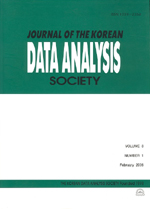범 중국 주식시장에서의 가격변동성의 비대칭적 반응에 관한 연구
Asymmetric Effect of News on Price Volatility in Pan-China Stock Markets
- 한국자료분석학회
- Journal of The Korean Data Analysis Society (JKDAS)
- Vol.18 No.4
-
2016.081961 - 1968 (8 pages)
- 9

본 연구에서는 범 중국 주식시장에서 정보의 호·악재에 따라 주가변동성의 비대칭적 반응이 존재하는 지의 여부를 분석하였다. 주가변동성의 대칭적 반응을 알아보는 GARCH 분석결과에 의하면, MSCI-China 지수, Hang-Seng Index 그리고 대만의 TAIEX 지수 모두 주가지수 수익률의 변동성은 시간에 따라 변한다는 것을 보여주었다. 그리고 GJR-MA(1) 모델을 이용한 범 중국시장의 주가지수 수익률의 변동성의 비대칭적 반응 여부에 대한 분석결과에 의하면, MSCI-China 지수를 이용한 중국 본토 주식시장뿐만 아니라 홍콩 주식시장 그리고 대만 주식시장의 세 주식시장 모두 주가변동성에서 비대칭적 반응을 보여주었다. 즉, 범 중국 주식시장 모두 예기치 못한 음의 수익률이 예기치 못한 양의 수익률보다 주가변동성을 더 크게 증가시킨다는 것을 보여주었다. 이는 주식시장에서의 악재가 호재의 경우보다 주가변동성에 미치는 영향이 더 크다는 것을 의미한다. 이 연구결과에 의하면, 범 중국 주식시장에서도 주식시장에 도착하는 정보가 주가변동성에 미치는 반응은 비대칭적이며, 또한 주가변동성을 예측할 때, 주식시장에서의 정보의 악재 및 호재 여부를 구분해야 한다는 것이다.
This study examines the asymmetric effect of news on price volatility in China, Hong Kong, and Taiwan stock markets. Empirical result using GARCH model that analyses an asymmetric response of stock price volatility shows that stock market volatilities of three stock markets are time-varying. For the empirical test of the asymmetric effect of news on stock price volatility, this study uses the modified GJR-MA(1) model which allows good news and bad news to have a different effect on volatility. This study finds that the unexpected negative return has a more remarkable effect on price volatility than the unexpected positive one does in all three stock markets. This means that the bad news of the stock markets gives a more crucial effect on volatility than good news does. Empirical evidence shows that since bad news might have a very different impacts on volatility than good news, it is very important to distinguish between positive and negative return shocks in the stock markets.
1. 서론
2. 연구방법론과 분석대상
3. 실증분석 결과
4. 결론
References
(0)
(0)